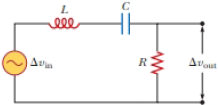
The resistor in Figure P32.49 represents the midrange speaker in a three-speaker system. Assume its resistance to be constant at 8.00 Ω. The source represents an audio amplifier producing signals of uniform amplitude ΔVmax = 10.0 V at all audio frequencies. The inductor and capacitor are to function as a band-pass filter with
Figure P32.49

(a)
Answer to Problem 33.77CP
Explanation of Solution
Given info: The value of resistance is
Formula to calculate the output potential difference is,
Here,
Formula to calculate the input potential difference is,
Here,
Divide equation (1) and equation (1).
Formula to calculate the inductive reactance of the circuit is,
Here,
Formula to calculate the inductive reactance of the circuit is,
Here,
Formula to calculate the impedance of the circuit is,
Here,
Substitute
At low frequency that is
Substitute
Substitute
Solve the equation further,
Divide the equation by
At high frequency that is
Substitute
Substitute
Solve the equation further,
Subtract the equation (5) and equation (6) to find the value of
Conclusion:
Therefore, the required value of inductance
(b)
Answer to Problem 33.77CP
Explanation of Solution
Given info: The value of resistance is
The equation (6) is given as,
Substitute
Conclusion:
Therefore, the required value of capacitance
(c)
Answer to Problem 33.77CP
Explanation of Solution
Given info: The value of resistance is
The value
At resonance condition,
Substitute
Conclusion:
Therefore, the maximum value of the ratio
(d)
Answer to Problem 33.77CP
Explanation of Solution
Given info: The value of resistance is
Since the ratio
Formula to calculate the resonance frequency is,
Substitute
Conclusion:
Therefore, the frequency
(e)
Answer to Problem 33.77CP
Explanation of Solution
Given info: The value of resistance is
Formula to calculate the phase shift between
At
Substitute
At
Substitute
At
Substitute
Conclusion:
Therefore, the phase shift between
(f)
Answer to Problem 33.77CP
Explanation of Solution
Given info: The value of resistance is
Formula to calculate the rms output voltage is,
Formula to calculate the power deliver to the speaker is,
Substitute
For low frequency
Substitute
Substitute
For resonance frequency
Substitute
Substitute
Conclusion:
Therefore, the average power transferred to the speaker at
(g)
Answer to Problem 33.77CP
Explanation of Solution
Given info: The value of resistance is
Formula to calculate the quality factor is,
Substitute
Conclusion:
Therefore, the quality factor of the circuit is
Want to see more full solutions like this?
Chapter 33 Solutions
Physics for Scientists and Engineers, Technology Update (No access codes included)
- Page 2 SECTION A Answer ALL questions in Section A [Expect to use one single-sided A4 page for each Section-A sub question.] Question A1 SPA6308 (2024) Consider Minkowski spacetime in Cartesian coordinates th = (t, x, y, z), such that ds² = dt² + dx² + dy² + dz². (a) Consider the vector with components V" = (1,-1,0,0). Determine V and V. V. (b) Consider now the coordinate system x' (u, v, y, z) such that u =t-x, v=t+x. [2 marks] Write down the line element, the metric, the Christoffel symbols and the Riemann curvature tensor in the new coordinates. [See the Appendix of this document.] [5 marks] (c) Determine V", that is, write the object in question A1.a in the coordinate system x'. Verify explicitly that V. V is invariant under the coordinate transformation. Question A2 [5 marks] Suppose that A, is a covector field, and consider the object Fv=AAμ. (a) Show explicitly that F is a tensor, that is, show that it transforms appropriately under a coordinate transformation. [5 marks] (b)…arrow_forwardHow does boiling point of water decreases as the altitude increases?arrow_forwardNo chatgpt pls will upvotearrow_forward
- 14 Z In figure, a closed surface with q=b= 0.4m/ C = 0.6m if the left edge of the closed surface at position X=a, if E is non-uniform and is given by € = (3 + 2x²) ŷ N/C, calculate the (3+2x²) net electric flux leaving the closed surface.arrow_forwardNo chatgpt pls will upvotearrow_forwardsuggest a reason ultrasound cleaning is better than cleaning by hand?arrow_forward
- Checkpoint 4 The figure shows four orientations of an electric di- pole in an external electric field. Rank the orienta- tions according to (a) the magnitude of the torque on the dipole and (b) the potential energy of the di- pole, greatest first. (1) (2) E (4)arrow_forwardWhat is integrated science. What is fractional distillation What is simple distillationarrow_forward19:39 · C Chegg 1 69% ✓ The compound beam is fixed at Ę and supported by rollers at A and B. There are pins at C and D. Take F=1700 lb. (Figure 1) Figure 800 lb ||-5- F 600 lb بتا D E C BO 10 ft 5 ft 4 ft-—— 6 ft — 5 ft- Solved Part A The compound beam is fixed at E and... Hình ảnh có thể có bản quyền. Tìm hiểu thêm Problem A-12 % Chia sẻ kip 800 lb Truy cập ) D Lưu of C 600 lb |-sa+ 10ft 5ft 4ft6ft D E 5 ft- Trying Cheaa Những kết quả này có hữu ích không? There are pins at C and D To F-1200 Egue!) Chegg Solved The compound b... Có Không ☑ ||| Chegg 10 וחarrow_forward
 Physics for Scientists and Engineers, Technology ...PhysicsISBN:9781305116399Author:Raymond A. Serway, John W. JewettPublisher:Cengage Learning
Physics for Scientists and Engineers, Technology ...PhysicsISBN:9781305116399Author:Raymond A. Serway, John W. JewettPublisher:Cengage Learning Physics for Scientists and Engineers: Foundations...PhysicsISBN:9781133939146Author:Katz, Debora M.Publisher:Cengage Learning
Physics for Scientists and Engineers: Foundations...PhysicsISBN:9781133939146Author:Katz, Debora M.Publisher:Cengage Learning
 Physics for Scientists and EngineersPhysicsISBN:9781337553278Author:Raymond A. Serway, John W. JewettPublisher:Cengage Learning
Physics for Scientists and EngineersPhysicsISBN:9781337553278Author:Raymond A. Serway, John W. JewettPublisher:Cengage Learning Physics for Scientists and Engineers with Modern ...PhysicsISBN:9781337553292Author:Raymond A. Serway, John W. JewettPublisher:Cengage Learning
Physics for Scientists and Engineers with Modern ...PhysicsISBN:9781337553292Author:Raymond A. Serway, John W. JewettPublisher:Cengage Learning College PhysicsPhysicsISBN:9781305952300Author:Raymond A. Serway, Chris VuillePublisher:Cengage Learning
College PhysicsPhysicsISBN:9781305952300Author:Raymond A. Serway, Chris VuillePublisher:Cengage Learning





